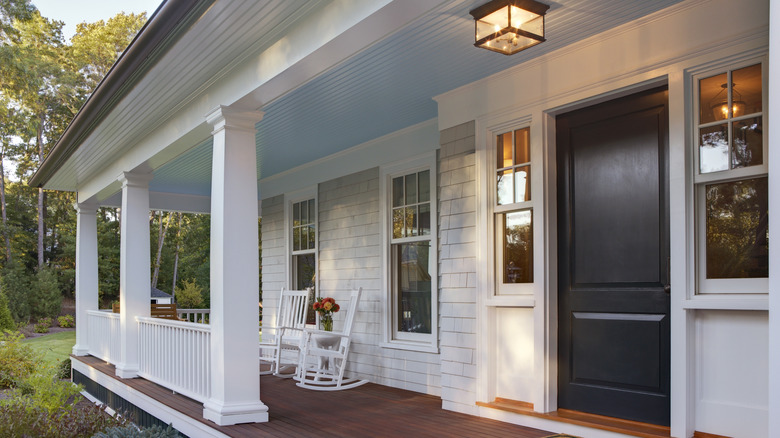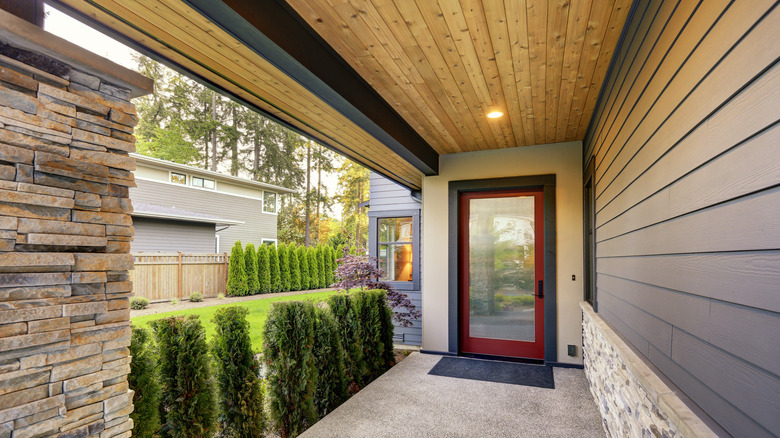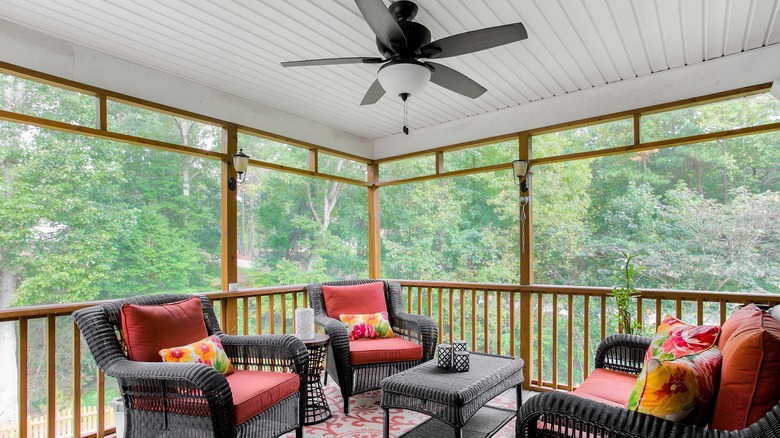Is PVC Beadboard A Good Material For Your Porch Ceiling?
Spending time outdoors can be a great way to relax, and one easy way to enjoy your outdoor space is on a porch. Whether you have already turned your front porch into an outdoor oasis or are looking to update the space, you may still need to consider building or renovating your porch's ceiling. One material that you may be thinking about for this project is PVC beadboard, but is this a good material to use? In an exclusive interview, House Digest asked Matt DiBara, fourth generation contractor and C-founder of The Contractor Consultants, his thoughts on PVC beadboard and other porch ceiling materials.
"In my professional opinion, PVC beadboard is actually a pretty solid choice for a porch ceiling," DiBara shared with House Digest. "It's lightweight, durable, and resistant to moisture, which is important for outdoor spaces like a porch. Unlike wood, it won't warp, rot, or swell when exposed to humidity or rain, which makes it a good low-maintenance option. It's also easy to clean and can handle the wear and tear of outdoor conditions without much effort."
DiBara also noted that, like most materials, PVC beadboard does come with a drawback. Unlike other wood materials, PVC beadboard won't give the ceiling a natural look, so if you are hoping for that style, it might be best to consider a different material. "It also tends to be a bit more expensive than other materials, especially when you're looking at higher-quality options," DiBara shared. "Additionally, PVC can expand and contract with temperature changes, so proper installation is key to prevent any issues over time."
Other materials to consider
With so many different outdoor patio ideas that can revamp your space, it can be difficult to choose what's best for you. When House Digest spoke exclusively with DiBara, he shared his thoughts on what material to use for a porch ceiling if PVC beadboard doesn't fit your needs.
"One solid option is wood, particularly cedar or pine. Wood offers a natural, warm look that PVC can't quite match. It's perfect if you want to add a more traditional or rustic feel to your porch," DiBara said. "The downside is that wood requires a bit more maintenance—it needs to be sealed or stained regularly to protect it from moisture and weathering. But if you're up for the upkeep, it can last a long time and ages well. Another good choice is tongue-and-groove PVC, which combines the durability of traditional PVC with the look of wood. This gives you the best of both worlds: the low-maintenance, moisture-resistant benefits of PVC, with the appearance of a wooden ceiling. It's a little more expensive, but if you want that wood-like aesthetic without constant care, it might be worth it."
Dibara also had a tip for anyone looking to keep costs low: "For those on a budget, plywood is also a viable option, but it needs to be treated for outdoor use. It's more affordable than wood or PVC and can be painted to match your porch's style. Keep in mind it may not hold up as well to the elements over time unless properly sealed." Focus on choosing a material that fits both your style and maintenance needs, rather than chasing trends.
Installing the PVC beadboard
If you've decided PVC beadboard is the material you want, you'll next want to know how to install it. Luckily, in our exclusive interview, House Digest asked DiBara how to begin this porch ceiling project. "First, make sure you measure your ceiling carefully to determine how much material you'll need," DiBara said. "PVC is lightweight and easy to handle, which makes it perfect for a DIY project. You'll want to start by securing your ceiling joists, ensuring they're spaced evenly, and then marking your reference points for where the beadboard panels will go."
"When it comes to installation, you'll need to cut the PVC panels to size using a saw designed for plastic. A fine-toothed saw works best to avoid rough edges." Make sure to work safely and use goggles and gloves when working with the material. According to Dibara: "Once your panels are cut, start from one corner of the porch and work your way across the ceiling. You can use a level to make sure each panel is straight and aligned. Fasten the panels into place with screws, not nails, since screws will hold better over time, especially in an outdoor environment. Once the panels are up, be sure to install any trim pieces to cover the edges and give your ceiling a clean, finished look. You can either glue or screw these into place, depending on the style you're going for. And that's it!"
Once your new porch ceiling is securely in place, you can focus on the rest of the porch. Consider creating some privacy in your outdoor space with these budget-friendly solutions!


